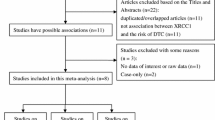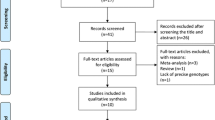Abstract
Papillary thyroid cancer (PTC) is a predominant type of thyroid cancer. Ionizing radiation is the only well-established risk factor and may result in double-strand breaks. The x-ray repair cross-complementing group 3 (XRCC3) gene plays a vital role in DNA repair through homologous recombination. We aimed at investigating the association between XRCC3 genetic polymorphisms and PTC susceptibility. Eighty-three PTC patients and 367 controls in a Chinese population were enrolled in the study. Tag single-nucleotide polymorphisms (SNPs) were identified by HaploView 4.2 software. Genomic DNAs were isolated from peripheral blood samples by using TaqMan Blood DNA kits. The genotyping of XRCC3 SNPs was performed by TaqMan SNPs genotyping assay. Odds ratios (ORs) and corresponding 95 % confidence intervals (CIs) were calculated to evaluate the association between XRCC3 SNPs and PTC susceptibility. The statistical analyses were conducted by using SPSS 13.0 software. Four tag-SNPs were initially identified by HaploView 4.2 software. Only one SNP (rs861539) was shown to be significantly associated with increased risk of PTC. There was a significant difference in smoking and drinking status between PTC cases and controls. And the stratified analysis suggested that the polymorphisms of rs861539 in XRCC3 were correlated with PTC risk in the four subgroups of smokers (ex-smokers included), non-smokers, drinkers (ex-drinkers included), and non-drinkers. The meta-analysis showed that only two studies reported a significant association between XRCC3 polymorphisms and PTC risk. In this study, we find a significant association between rs861539 polymorphisms and PTC susceptibility. However, there were inconsistent results in previous published studies. Therefore, further studies in a large population are required to gain insights into the PTC risk conferred by XRCC3 SNPs.



Similar content being viewed by others
References
Adam MA, Pura J, Goffredo P, Dinan MA, Hyslop T, Reed SD, et al. Impact of extent of surgery on survival for papillary thyroid cancer patients younger than 45 years. J. Clin Endocrinol Metab. 2014;100:115–121.
Vigneri R, Malandrino P, Vigneri P. The changing epidemiology of thyroid cancer: why is incidence increasing? Curr Opin Oncol. 2015;27:1–7.
Nikiforov YE, Nikiforova MN. Molecular genetics and diagnosis of thyroid cancer. Nat Rev Endocrinol. 2011;7:569–80.
Siegel R, DeSantis C, Virgo K, Stein K, Mariotto A, Smith T, et al. Cancer treatment and survivorship statistics, 2012. CA Cancer J Clin. 2012;62:220–41.
Schlumberger M, Cailleux AF, Suarez HG, de Vathaire F. Irradiation and second cancers. The thyroid as a case in point. C R Acad Sci III. 1999;322:205–13.
Czene K, Lichtenstein P, Hemminki K. Environmental and heritable causes of cancer among 9.6 million individuals in the Swedish family‐cancer database. Int J Cancer. 2002;99:260–6.
Frigerio N, Stowe R. Carcinogenic and genetic hazard from background radiation. In: Biological and environmental effects of low-level radiation. 1976.
Kaina B. DNA damage-triggered apoptosis: critical role of DNA repair, double-strand breaks, cell proliferation and signaling. Biochem Pharmacol. 2003;66:1547–54.
Wolff S, Afzal V, Wiencke JK, Olivieri G, Michaeli A. Human lymphocytes exposed to low doses of ionizing radiations become refractory to high doses of radiation as well as to chemical mutagens that induce double-strand breaks in DNA. Int J Radiat Biol. 1988;53:39–48.
Thacker J, Zdzienicka MZ. The < i > XRCC</i > genes: expanding roles in DNA double-strand break repair. DNA Repair. 2004;3:1081–90.
Brenneman MA, Weiss AE, Nickoloff JA, Chen DJ. < i > XRCC3</i > is required for efficient repair of chromosome breaks by homologous recombination. Mutation Research/DNA Repair. 2000;459:89–97.
Bishop DK, Ear U, Bhattacharyya A, Calderone C, Beckett M, Weichselbaum RR, et al. Xrcc3 is required for assembly of Rad51 complexes in vivo. J Biol Chem. 1998;273:21482–8.
Liu Y, Masson J-Y, Shah R, O’Regan P, West SC. RAD51C is required for Holliday junction processing in mammalian cells. Science. 2004;303:243–6.
Jones NJ, Cox R, Thacker J. Isolation and cross-sensitivity of x-ray-sensitive mutants of V79-4 hamster cells. Mutation Research/DNA Repair Reports. 1987;183:279–86.
Goode EL, Ulrich CM, Potter JD. Polymorphisms in DNA repair genes and associations with cancer risk. Cancer Epidemiol Biomark Prev. 2002;11:1513–30.
Jin M-J, Chen K, Song L, Fan C-H, Chen Q, Zhu Y-M, et al. The association of the DNA repair gene < i > XRCC3</i > Thr241Met polymorphism with susceptibility to colorectal cancer in a Chinese population. Cancer Genet Cytogenet. 2005;163:38–43.
Krupa R, Blasiak J. An association of polymorphism of DNA repair genes XRCC1 and XRCC3 with colorectal cancer. J Exp Clin Cancer Res. 2004;23:285–94.
Mittal RD, Gangwar R, Mandal RK, Srivastava P, Ahirwar DK. Gene variants of XRCC4 and XRCC3 and their association with risk for urothelial bladder cancer. Mol Biol Rep. 2012;39:1667–75.
Auranen A, Song H, Waterfall C, DiCioccio RA, Kuschel B, Kjaer SK, et al. Polymorphisms in DNA repair genes and epithelial ovarian cancer risk. Int J Cancer. 2005;117:611–8.
Akulevich NM, Saenko VA, Rogounovitch TI, Drozd VM, Lushnikov EF, Ivanov VK, et al. Polymorphisms of DNA damage response genes in radiation-related and sporadic papillary thyroid carcinoma. Endocr Relat Cancer. 2009;16:491–503.
Bastos HN, Antao MR, Silva SN, Azevedo AP, Manita I, Teixeira V, et al. Association of polymorphisms in genes of the homologous recombination DNA repair pathway and thyroid cancer risk. Thyroid. 2009;19:1067–75.
Siraj AK, Al-Rasheed M, Ibrahim M, Siddiqui K, Al-Dayel F, Al-Sanea O, et al. RAD52 polymorphisms contribute to the development of papillary thyroid cancer susceptibility in Middle Eastern population. J Endocrinol Invest. 2008;31:893–9.
Sturgis EM, Zhao C, Zheng R, Wei Q. Radiation response genotype and risk of differentiated thyroid cancer: a case-control analysis. Laryngoscope. 2005;115:938–45.
Lengauer C, Kinzler KW, Vogelstein B. Genetic instabilities in human cancers. Nature. 1998;396:643–9.
Polo SE, Jackson SP. Dynamics of DNA damage response proteins at DNA breaks: a focus on protein modifications. Genes Dev. 2011;25:409–33.
Zhou B-BS, Elledge SJ. The DNA damage response: putting checkpoints in perspective. Nature. 2000;408:433–9.
Hartwell LH, Kastan MB. Cell cycle control and cancer. Science. 1994;266:1821–8.
Araujo FD, Pierce AJ, Stark JM, Jasin M. Variant XRCC3 implicated in cancer is functional in homology-directed repair of double-strand breaks. Oncogene. 2002;21:4176–80.
Hamdy MS, El-Haddad AM, El-Din NMB, Makhlouf MM, Abdel-Hamid SM. RAD51 and XRCC3 gene polymorphisms and the risk of developing acute myeloid leukemia. J Investig Med. 2011;59:1124–30.
Seedhouse C, Faulkner R, Ashraf N, Das-Gupta E, Russell N. Polymorphisms in genes involved in homologous recombination repair interact to increase the risk of developing acute myeloid leukemia. Clin Cancer Res. 2004;10:2675–80.
Zhou K, Liu Y, Zhang H, Liu H, Fan W, Zhong Y, et al. XRCC3 haplotypes and risk of gliomas in a Chinese population: a hospital‐based case‐control study. Int J Cancer. 2009;124:2948–53.
Matullo G, Guarrera S, Carturan S, Peluso M, Malaveille C, Davico L, et al. DNA repair gene polymorphisms, bulky DNA adducts in white blood cells and bladder cancer in a case‐control study. Int J Cancer. 2001;92:562–7.
Winsey SL, Haldar NA, Marsh HP, Bunce M, Marshall SE, Harris AL, et al. A variant within the DNA repair gene XRCC3 is associated with the development of melanoma skin cancer. Cancer Res. 2000;60:5612–6.
David-Beabes GL, Lunn RM, London SJ. No association between the XPD (Lys751G1n) polymorphism or the XRCC3 (Thr241Met) polymorphism and lung cancer risk. Cancer Epidemiol Biomark Prev. 2001;10:911–2.
Misra RR, Ratnasinghe D, Tangrea JA, Virtamo J, Andersen MR, Barrett M, et al. Polymorphisms in the DNA repair genes < i > XPD, XRCC1, XRCC3</i > and < i > APE/ref-1</i > and the risk of lung cancer amongmale smokers in Finland. Cancer Lett. 2003;191:171–8.
Duarte MC, Colombo J, Rossit ARB, Caetano A, Borim AA, Wornrath D, et al. Polymorphisms of DNA repair genes XRCC1 and XRCC3, interaction with environmental exposure and risk of chronic gastritis and gastric cancer. World J Gastroenterol. 2005;11:6593.
Shen H, Wang X, Hu Z, Zhang Z, Xu Y, Hu X, et al. Polymorphisms of DNA repair gene < i > XRCC3</i > Thr241Met and risk of gastric cancer in a Chinese population. Cancer Lett. 2004;206:51–8.
Brooks J, Shore RE, Zeleniuch-Jacquotte A, Currie D, Afanasyeva Y, Koenig KL, et al. Polymorphisms in RAD51, XRCC2, and XRCC3 are not related to breast cancer risk. Cancer Epidemiol Biomark Prev. 2008;17:1016–9.
Jacobsen NR, Nexø BA, Olsen A, Overvad K, Wallin H, Tjønneland A, et al. No association between the DNA repair gene XRCC3 T241M polymorphism and risk of skin cancer and breast cancer. Cancer Epidemiol Biomark Prev. 2003;12:584–5.
Thyagarajan B, Anderson KE, Folsom AR, Jacobs Jr DR, Lynch CF, Bargaje A, et al. No association between XRCC1 and XRCC3 gene polymorphisms and breast cancer risk: Iowa Women’s Health Study. Cancer Detect Prev. 2006;30:313–21.
Ritchey JD, Huang W-Y, Chokkalingam AP, Gao Y-T, Deng J, Levine P, et al. Genetic variants of DNA repair genes and prostate cancer: a population-based study. Cancer Epidemiol Biomark Prev. 2005;14:1703–9.
Conflict of interest
None
Author information
Authors and Affiliations
Corresponding author
Additional information
Kai Yuan and Meiling Huo are first co-authors of this manuscript.
Kai Yuan and Meiling Huo contributed equally to this work.
Rights and permissions
About this article
Cite this article
Yuan, K., Huo, M., Sun, Y. et al. Association between x-ray repair cross-complementing group 3 (XRCC3) genetic polymorphisms and papillary thyroid cancer susceptibility in a Chinese Han population. Tumor Biol. 37, 979–987 (2016). https://doi.org/10.1007/s13277-015-3882-4
Received:
Accepted:
Published:
Issue Date:
DOI: https://doi.org/10.1007/s13277-015-3882-4




